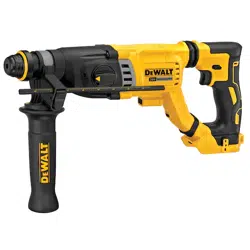Loading ...
Loading ...
Loading ...

ENGLISH
11
Symbol Mode Application
Hammerdrilling
Drilling into concrete
and masonry
Hammering
only
Lightchipping
Drilling
Drilling into metal,
wood and masonry
To Select an Operating Mode (Fig. I)
• Press the mode selector button
5
and rotate the mode
selector dial
4
so that the arrow points to the symbol
corresponding for the desiredmode.
Fig. I
4
5
NOTE: The arrow on the mode selector dial
4
must be
pointing at a mode symbol at all times. There are no
operable positions inbetween. It may be necessary to briefly
run the motor after having changed from 'hammering only'
to 'rotary' modes in order to align thegears or to postion
the chiselbit.
Drilling (Fig. I)
WARNING: To reduce the risk of personal injury,
ALWAYS operate the tool with the side handle
properly installed. Failure to do so may result in
the side handle slipping during tool operation and
subsequent loss of control. Hold tool with both hands
to maximizecontrol.
WARNING: TO REDUCE THE RISK OF PERSONAL
INJURY, ALWAYS ensure workpiece is anchored or
clamped firmly. If drilling thin material, use a wood
“back-up” block to prevent damage to thematerial.
NOTICE: If drilling thin material, use a wood
“back-up” block to prevent damage to thematerial.
1. Press the mode selector button
5
and rotate the mode
selector dial
4
to the drilling symbol.
2. Use sharp drill bits only. For wood, use twist bits,
spade bits, power auger bits or hole saws. For metal,
use high-speed steel twist drill bits or hole saws. Use a
cutting lubricant when drilling metals. The exceptions
are cast iron and brass which should be drilled dry. For
masonry, such as brick, cement, cinder block, etc., use
carbide-tipped bits rated for percussiondrilling.
3. Always apply pressure in a straight line with the bit. Use
enough pressure to keep drill biting, but do not push
hard enough to stall the motor or deflect thebit.
4. Hold tool firmly with both hands to control the twisting
action of the drill. If model is not equipped with side
handle, grip drill with one hand on the handle and one
hand on the batterypack.
WARNING: Drill may stall if overloaded causing a
sudden twist. Always expect the stall. Grip the drill
firmly to control the twisting action and avoidinjury.
5. IF DRILL STALLS, it is usually because it is being
overloaded or improperly used. RELEASE TRIGGER
IMMEDIATELY, remove drill bit from work, and
determine cause of stalling. DO NOT depress TRIGGER
ON AND OFF IN AN ATTEMPT TO START A STALLED
DRILL—THIS CAN DAMAGE THEDRILL.
6. To minimize stalling or breaking through the material,
reduce pressure on drill and ease the bit through the
last fractional part of thehole.
7. Keep the motor running when pulling the bit back out
of a drilled hole. This will help preventjamming.
8. With variable speed drills there is no need to center
punch the point to be drilled. Use a slow speed to start
the hole and accelerate by squeezing the trigger harder
when the hole is deep enough to drill without the bit
skippingout.
Drilling in Metal
A SDSPLUS to round shank adaptor chuck is required.
Ensure that tool is in Drilling mode. Start drilling with
slow speed and increase to full power while applying firm
pressure on the tool. A smooth even flow of metal chips
indicates the proper drilling rate. Use a cutting lubricant
when drilling metals. The exceptions are cast iron and brass
which should be drilleddry.
NOTE: Large (5/16" to 1/2" [7.9 mm to 12.7 mm]) holes
in steel can be made easier if a pilot hole (5/32" to 3/16"
[4mm to 4.8 mm]) is drilledfirst.
Drilling in Wood
A SDSPLUS to round shank adaptor chuck is required.
Ensure that tool is in Drilling mode. Start drilling with
slow speed and increase to full power while applying firm
pressure on the tool. Holes in wood can be made with the
same twist drills used for metal. These bits may overheat
unless pulled out frequently to clear chips from the flutes.
For larger holes, use spade bits, power auger bits, or hole
saws. Work that is apt to splinter should be backed up with
a block ofwood.
Drilling in Masonry
When drilling in masonry, use carbide-tipped bits rated for
percussion drilling and be certain that the bits are sharp.
Use a constant and firm force on the tool to drill most
effectively. A smooth, even flow of dust indicates the proper
drillingrate.
Hammerdrill Operation (Fig. I)
1. Press the mode selector button
5
and rotate the mode
selector dial
4
to the hammerdrilling symbol.
Loading ...
Loading ...
Loading ...
